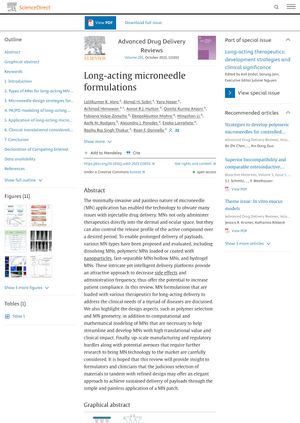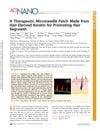Long-Acting Microneedle Formulations
August 2023
in “
Advanced Drug Delivery Reviews
”

TLDR Microneedles are promising for long-acting drug delivery and can improve patient compliance, but more data is needed to confirm their effectiveness.
The document reviews the use of microneedles (MNs) for long-acting drug delivery. MNs are minimally invasive systems that can deliver a variety of therapeutics directly into the dermal and ocular space, potentially increasing patient compliance. Different types of MNs, including dissolving, polymeric, fast-separable, hollow, and hydrogel MNs, have been evaluated. The design of MNs, including factors like the radius of the needle tip, needle height, base width, interspacing between needles, aspect ratio, and shape, plays a crucial role in their effectiveness. The document also discusses the use of different polymeric matrices for the long-acting dissolving/degrading type, including PLGA, PLA/PLGA, PCL, silk fibroin, chitosan, and gelatin. MNs have been used for various applications, including vaccination, cancer therapy, diabetes management, and treatment of skin diseases. For instance, a contraceptive patch using MNs to deliver a long-acting contraceptive hormone, levonorgestrel, can be applied for up to three weeks. MNs can also be used to deliver insulin to diabetic patients over a period of days, reducing the need for frequent injections. Despite promising results, more positive preclinical and clinical data are needed to fully appreciate the promise of this unique drug delivery technology.




